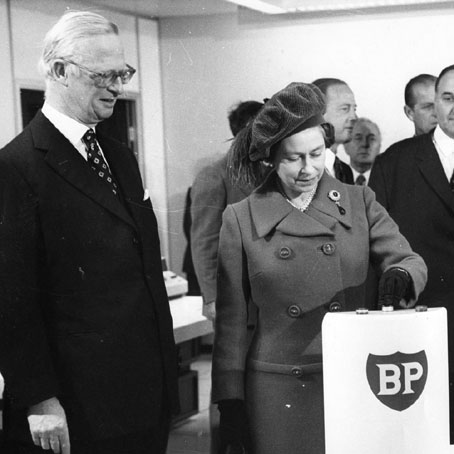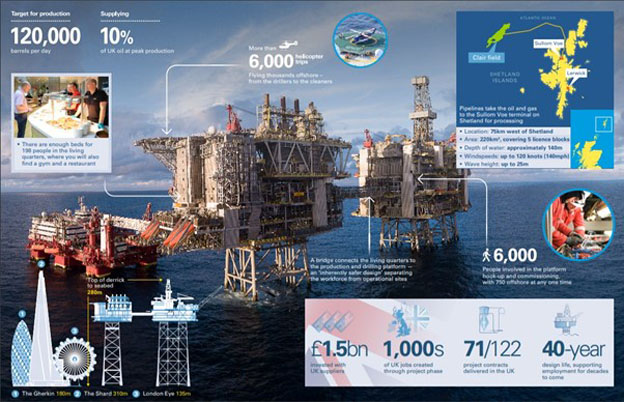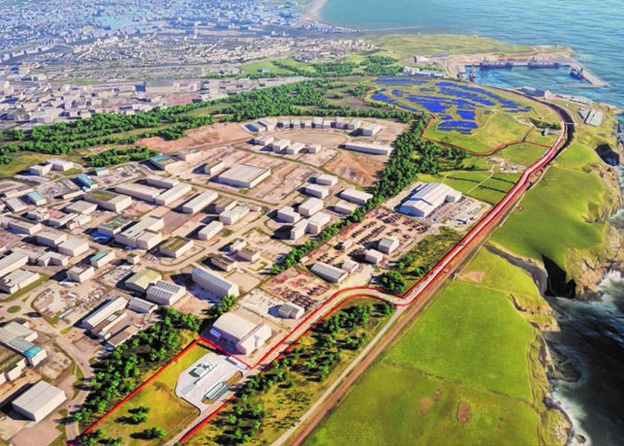Over the past six decades, bp’s presence in the North Sea has helped to meet the energy needs of millions and contributed billions of pounds to the UK economy.
The North Sea is providing the UK with more than oil and gas alone. It is an engine for progress, helping to spread energy and expertise across the globe.
bp has been in the North Sea for the past 60 years – an industry pioneer. With safety as the first priority, bp has supported the development of technologies, skills and more. And this has happened in some of the world’s most challenging conditions, from high winds to large waves.
In September 1964, bp received its first licence to explore in the North Sea. Eleven years later, Queen Elizabeth II pressed a symbolic button in bp’s control centre in Aberdeen, officially beginning production from the Forties field.
These are just two of the milestones that heralded the growth of the North Sea into one of the UK’s biggest economic success stories. Today, bp's portfolio is focused around five key production hubs in the Central North Sea and west of Shetland.
bp aims to continue investing in the North Sea to deliver oil and gas that can be produced safely, reliably, and competitively, maximizing the resources and infrastructure around their existing hubs.
And bp are also working to help lay the groundwork for the energy transition. In the city bp has called home for 60 years, they have formed a joint venture with Aberdeen City Council to develop the Aberdeen Hydrogen Hub – a green hydrogen production, storage and distribution facility, powered by renewable energy.
“From the award of our first exploration licence in 1964, bp has helped to pioneer the UK oil and gas industry. Today, we remain one of the largest holders of undeveloped barrels in the North Sea, with a portfolio of offshore facilities safely operated by a dedicated workforce who spend weeks at a time away from their loved ones, working round the clock in all seasons to help produce the energy the world still needs,” says Doris Reiter, SVP, North Sea. “I’m firmly of the view that bp’s legacy in regions like the North Sea provides the foundations from which a successful energy transition can be delivered.”
Timeline
1964 First offshore licence
In September bp is granted its first UK North Sea licence and begins exploration immediately. The company becomes one of the first to use two-dimensional seismic imaging to map the North Sea’s reservoirs. From the very early days, bp has developed and adopted technology to maximize the region’s potential.
1965 Gas discovery
A first on the UK continental shelf, bp strikes natural gas at West Sole in the southern North Sea with its first North Sea offshore drill rig, Sea Gem. In March 1967 bp piped the first North Sea gas from the field to the first landing point for all the UK’s natural gas, Easington terminal on the Yorkshire coast.
Early tragedy: On 27 December tragedy strikes when Sea Gem collapses and sinks during a moving operation. Of the 32 men on board, 13 tragically lost their lives and one sadly passed away in the days that followed. New safety regulations were brought in as a consequence of the accident, including the legal requirement to have an offshore installation manager on every platform.
1970 First UK giant oilfield
In October bp discovers what would become one of the jewels in its crown: the Forties field, 180km east of Aberdeen. bp’s engineers immediately set to work building a series of connecting pipelines, as well as terminal facilities to transport, process and store this energy resource. At the time, the pipeline was the largest deepwater pipeline ever constructed.
1974-1977 Four field discoveries
By mid-1970s bp’s exploration team is enjoying significant success in the North Sea. The Magnus and Andrew fields are discovered in 1974, with Rhum and Clair following in 1977. With the exception of Magnus, which began producing in 1983, it will be decades until technology in the industry has developed sufficiently to access these hard to reach hydrocarbons.
1975 First North Sea oil comes ashore

First oil from the Forties field flows through bp’s newly built Forties Pipeline System (FPS) on 3 November 1975. Queen Elizabeth II officially begins production by pushing a symbolic gold-plated button in bp’s control centre in Aberdeen. Harold Wilson, the Prime Minister, watches on.
1992-1993 bp opens up the west of Shetland area
Exploration in the deep waters of the Shetland Trough in the North West Atlantic begins in 1972, but it is bp that makes the first commercially viable discovery in 1992 at Foinaven. The Schiehallion field is discovered a year later.
1992-1998 Miller, Andrew and ETAP fields begin production
bp celebrates first oil from three central North Sea fields over six years; Miller in 1992, Andrew in 1996 and Eastern Trough Area Project (ETAP) two years later. At the time of development, the individual reservoirs in the ETAP area are not deemed to be commercially viable on a stand-alone basis, so an alliance is formed to develop the fields as one joint development.
1994 bp Student Tutoring scheme
bp launches the first iteration of the bp Student Tutoring scheme – a partnership still going strong today with Aberdeenshire and Aberdeen City councils and three higher and further education institutions – inspiring the region’s young people to progress into higher education by placing students into classrooms in north-east Scotland schools.
2000 Partnering for biodiversity
bp commits £10 million to the newly formed Scottish Forest Alliance, which over time helps create 14 new native woodlands. The partnership still thrives today and in 2023 bp committed a further £10 million to a new urban forestry programme delivering greener cities, towns and urban areas.
2005 Development of Europe’s largest oilfield begins

With an estimated seven billion barrels of oil in place, Clair is considered the largest oilfield on the UK Continental Shelf. Discovered in 1977, it is only with significant advances in technology and innovative engineering that the first phase of development is made possible through Clair Phase One, the first fixed platform west of Shetland.
2017-2018 Starting up west of Shetland
A major redevelopment of the Schiehallion and Loyal fields in 2017 includes construction and installation of the Glen Lyon FPSO and upgrading of subsea facilities to prolong the life of the hub.
Clair Ridge, the second phase of development of the Clair field, starts up the following year.
2022 Aberdeen Hydrogen Hub

In March 2022 Aberdeen City Council and bp formed a joint venture called bp Aberdeen Hydrogen Energy Limited (bpAHEL). The partnership intends to enhance the hydrogen economy in Aberdeen city and the northeast of Scotland by building the Aberdeen Hydrogen Hub, a green hydrogen production, storage and distribution facility, powered by a new solar plant and additional renewable energy sources.
2023 Harnessing the power of Scotland’s wind
Renewable energy from wind will be a vital part of the country’s energy mix, as it transitions to net zero. That is why in 2023, along with their partner EnBW, bp progressed the planning of the Morven offshore wind farma in the North Sea, off the coast of Aberdeenshire.
KeyFacts Energy: bp UK country profile l KeyFacts Energy: Energy History
 KEYFACT Energy
KEYFACT Energy